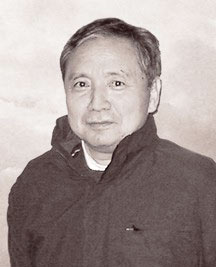 W
WHideaki Anno is a Japanese animator, filmmaker and actor. He is best known for creating the anime series Neon Genesis Evangelion (1995). His style is defined by his postmodernist approach and the extensive portrayal of characters' thoughts and emotions, often through unconventional scenes presenting the mental deconstruction of those characters. The Evangelion franchise has had a significant influence on the anime television industry and Japanese popular culture, with many deeming Anno as one of the medium's first auteurs.
 W
WShingo Araki was a Japanese animation artist and character designer.
 W
WToshihiro Iijima , also known by the names Kitao Senzoku , and Jōtarō Jitōin , was a Japanese film and television director, producer, and screenwriter.
 W
WRikiya Imaizumi is a Japanese film director.
 W
WIsamu Imakake is a Japanese animator, screenwriter, television director and producer. He also worked as illustrator for some manga like Geobreeders.
 W
WAkio Jissoji was a Japanese television and film director best known outside Japan for the 1960s TV series Ultraman and Ultraseven, as well as for his auteur erotic ATG-produced Buddhist trilogy Mujō (無常), Mandala (曼陀羅), and Uta (哥).
 W
WYoshiji Kigami was a Japanese animator, director and storyboarder. He started working at Shin-Ei Animation, later became part of Animaruya and then he became affiliated with Kyoto Animation.
 W
WKazuho Mitsuta , also known by the name Kiyose Kazuho , is a Japanese film and television director and producer. He is one of several people who have been given credit for creating Ultraman.
 W
WKeishi Ōtomo is a Japanese film and television director and screenwriter, best known for the Rurouni Kenshin film series.
 W
WKoichi Sakamoto is a Japanese-born stunt actor, and producer for films and television. He is best known for his work as executive producer, as well as fight coordinator and frequent director, for the long running Power Rangers franchise.
 W
WKazuya Shiraishi is a Japanese filmmaker.
 W
WKōbun Shizuno is a Japanese anime film and television director.
 W
WYasuhiro Takemoto was a Japanese animator and television and film director. He worked at Kyoto Animation for almost his entire animation career after joining the company in 1996 until his death in 2019.
 W
WOsamu Tezuka was a Japanese manga artist, cartoonist, and animator. Born in Osaka Prefecture, his prolific output, pioneering techniques, and innovative redefinitions of genres earned him such titles as "the Father of Manga" , "the Godfather of Manga" and "the God of Manga" . Additionally, he is often considered the Japanese equivalent to Walt Disney, who served as a major inspiration during Tezuka's formative years. Though this phrase praises the quality of his early manga works for children and animations, it also blurs the significant influence of his later, more literary, gekiga works.
 W
WYukihiko Tsutsumi is a Japanese television and film director. He began directing commercials and music promotion videos as an employee of Nihon Television. After spending time abroad, he returned and started his own production company, Office Crescendo, from which he works independently. His first television drama on Nihon Television was called Kora! Tonneruzu and ran from 1985 to 1989. He directed Taitei no Ken, an original work by Baku Yumemakura, in 2007.
 W
WShinichirō Watanabe is a Japanese anime television and film director, best known for directing the critically acclaimed and commercially successful anime series Cowboy Bebop and Samurai Champloo. An auteur of the industry, Watanabe's work is characterized by evocative uses of music, mature themes, and the incorporation of multiple genres.
 W
WNaoko Yamada born Nov. 28th 1985, is a Japanese animator, television and film director. Working at Kyoto Animation, she directed the anime series K-On! (2009-2010) and Tamako Market (2013), and the anime films A Silent Voice (2016) and Liz and the Blue Bird (2018).
 W
WYoshikazu Yasuhiko is a Japanese animator, manga artist, and director in the anime industry.